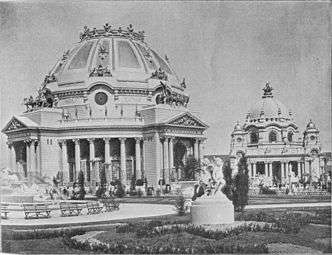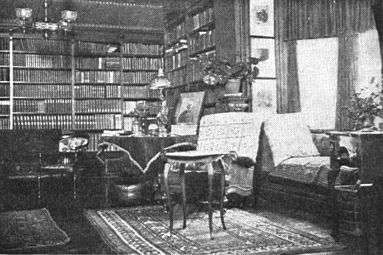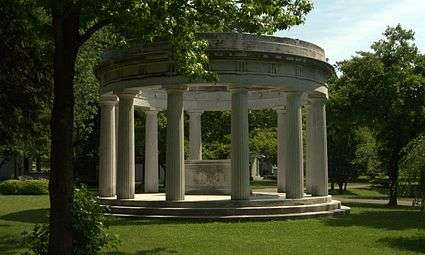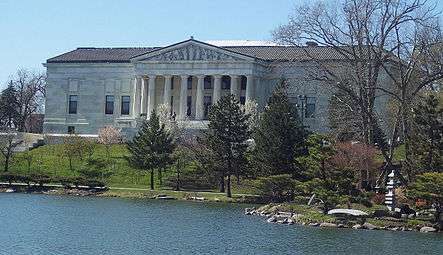George Cary (architect)
| George Cary | |
|---|---|
 Cary in 1902 | |
| Born |
1859 Buffalo, New York |
| Died |
May 5, 1945 (aged 86) Buffalo, New York |
| Nationality | American |
| Alma mater |
Harvard College (1883) Columbia University L'Ecole des Beaux-Arts |
| Occupation | Architect |
| Spouse(s) | Allithea Birge |
| Parent(s) |
Walter Cary Julia Love |
George Cary (1859– May 5, 1945),[1] was a major American architect from New York State known for his designs for the Pan American Exposition of 1901 in Buffalo, New York.[2]
Early life and education
George Cary was born in 1859, the son of prominent Buffalo resident, Dr. Walter Cary (1818-1881) and Julia Cary (née Love). George was the grandson of Trumbull Cary (1787-1869), a New York State Senator and Assemblyman.[1] Together, Walter and Julia had seven children:[3] Trumbull Cary (1849-1913), Thomas Cary (1851-1921), Charles Cary (1852-1931), who in 1879 married Evelyn Rumsey (1855-1924), Jennie Cary (1854-1943), who in 1876 married Laurence D. Rumsey (1849-1917) and was the father of Charles Cary Rumsey (1879–1922), who married Mary Harriman (1881–1934), daughter of E. H. Harriman (1848-1909) and Mary Williamson (1851-1932), Walter Cary Jr. (1857-1933), George Cary (1859-1945), and Seward Cary (1862-1948), who married Emily Scatcherd (1862-1934)[3]
Cary attended and graduated from Harvard and the Columbia School of Architecture. After graduating from Columbia, Cary spent a brief apprenticeship with McKim, Mead and White in New York City. Directly after that, he went to Paris and studied at the Ecole des Beaux-Arts from 1886 until 1889, the first Buffalonian to do so.[2]
Career
In 1891, he returned to Buffalo and set up practice. In the mid-1890s, Cary redesigned some rooms in the Ansley Wilcox House,[4] which later became known as Theodore Roosevelt Inaugural National Historic Site as it was the site where Theodore Roosevelt took the oath of office as President of the United States on September 14, 1901 after the assassination of William McKinley at the Pan-American Exposition of 1901.[5]
When the Exposition came to Buffalo, Cary became one of the three local architects on the Board of Architects for the Exposition and designed the Ethnology Building[4] and the New York State pavilion for the Pan-American Exposition. The pavilion was the only permanent building created for the Exposition and later became the Buffalo Historical Society, then the Buffalo and Erie County Historical Society, and today is the Buffalo History Museum.[2]
Cary was a founder of the Beaux-Arts Institute of Design, served as president of the American Institute of Architects (and a member for 53 years), a director of the Albright Art Gallery, member of the Fine Arts Academy.[6]
Notable projects
- Buffalo History Museum (1901)
- Ethnology Building (1901)
- Pierce-Arrow Motor Car Company Administration Building (1906-1907)
- Buffalo General Hospital[4]
- University at Buffalo buildings[6]
- Buffalo Country Club[6]
- Forest Lawn's Delaware Avenue Gate (Neoclassical)[4]
- Forest Lawn Administration Building (Neoclassical)[4]
Gallery
-

Ethnology Building
-

Interior of room in Wilcox House where Theodore Roosevelt took the oath of Presidency
-

The Birge Memorial for George K. Birge, president of the Pierce-Arrow Motor Car Company.
Personal life
In 1908, He married Allithea Birge, daughter of George K. Birge and Carrie Birge (Birge wallpaper and Pierce-Arrow cars). Cary also designed his home at 460 Franklin Street in the Italianate style.[2] Together they had:
- George Cary, Jr.[6] (1911-1971)[7]
- Allithea M. B. Cary[6] (1913-1993), who married Francis E. Largo (1915-1969)[8]
- Maria Love Cary[6] (1915-2009),[9] who married Howard Bissell, Jr. (b. 1913),[10] the nephew of Wilson S. Bissell[11]
- Charles Cary[6] (1916-1985)[12]
Allithea died in 1918 and he died in 1945, at eighty-six. Both are buried in Forest Lawn Cemetery in Buffalo.[6]
References
- 1 2 Cramer, Catherine. "George Cary". findagrave.com. Find A Grave Memorial. Retrieved 4 April 2016.
- 1 2 3 4 Staff. "George Cary (1859-1945)". burchfieldpenney.org. Burchfield-Penney Art Center. Retrieved 4 April 2016.
- 1 2 LaChiusa, Chuck. "Cary Family / Love Family of Buffalo, NY". buffaloah.com. Buffalo Architecture and History. Retrieved 4 April 2016.
- 1 2 3 4 5 LaChiusa, Chuck. "George Cary in Buffalo, NY". buffaloah.com. Buffalo Architecture and History. Retrieved 4 April 2016.
- ↑ "The House at 641 Delaware". Theodore Roosevelt Inaugural National Historic Site. National Park Service. 2006-12-13. Retrieved 2007-10-18.
- 1 2 3 4 5 6 7 8 Staff (May 6, 1945). "GEORGE GARY DIES NOTED ARCHITECT Former Head of the American Institute Was a Founder of Beaux-Arts Here". The New York Times. Retrieved 5 April 2016.
- ↑ Silva, Dan. "George Cary". findagrave.com. Find A Grave Memorial. Retrieved 7 April 2016.
- ↑ Meyer, Phyllis. "Allithea Cary Largo". findagrave.com. Find A Grave Memorial. Retrieved 7 April 2016.
- ↑ Staff (June 9, 2009). "Maria Love Bissell". Florida Times-Union. Retrieved 7 April 2016.
- ↑ Robinson, Jean; Wheeler II, Charles B. ; and Bissell, Roger. "Vital Statistics for descendants of Noah Bissell III and Solomon Bissell". rogerbissell.com. BHAM Vol. 1 No. 4. Retrieved 5 April 2016.
- ↑ Staff (January 19, 1936). "Bissell-Cary Nuptials Unite Prominent Families" (PDF). Buffalo Courier Express. Retrieved 5 April 2016.
- ↑ Meyer, Phyllis. "LCDR Charles Cary". findagrave.com. Find A Grave Memorial. Retrieved 7 April 2016.
